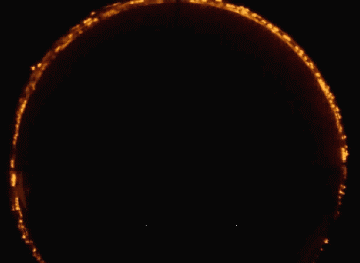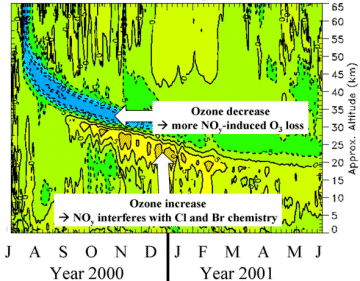 Where's Saturn? Is that a UFO--or the ISS? What's the name of that star? Get the answers from mySKY--a fun new astronomy helper from Meade. . Where's Saturn? Is that a UFO--or the ISS? What's the name of that star? Get the answers from mySKY--a fun new astronomy helper from Meade. . AURORA WATCH: A solar wind stream is due to hit Earth tonight, possibly triggering a mild geomagnetic storm. High latitude sky watchers should be alert for auroras. NEW MEXICO FIREBALL: On Sept 13th at approximately 3 o'clock in the morning MDT, an extremely bright fireball streaked over New Mexico, "It was terrifying," says eyewitness Susan K. Burgess. "I was stargazing outside my house near Santa Fe when the landscape started becoming very bright, as if a brilliant full moon was quickly rising from the southwest. The fireball itself [slowly moved] over the house and disintegrated with a great deal of scatter in the northwest sky." At the Sandia National Labs in Albuquerque, a Sentinel all-sky video camera captured the fireball in flight: 
Click to view the complete movie.
Based on data from the video, the visual magnitude of the fireball was -14.6, about four times brighter than a full Moon! "The fireball was a pure emerald green, uncomfortably bright to look at," adds Harald Edens located in the Magdalena Mountains west of Socorro, NM. "The object was disintegrating when I saw it, with pieces parallel-tracking and trailing the fireball. Those smaller pieces had all different colors--most notably red. I think it has been a piece of space junk." Amateur radio astronomer Thomas Ashcraft not only photographed the fireball, but also recorded echos of a distant radio station bouncing off the meteor's ionized trail: movie. "This fireball turned night into day!" he says. Stay tuned for updates. NOXIOUS ACTIVITY: Scientists attending the Living With a Star workshop in Boulder, Colorado, learned yesterday that solar storms can have long-lasting effects on Earth's ozone layer. Charles Jackman of the Goddard Space Flight Center reported that solar protons hitting Earth in July 2000 altered the chemistry of the upper atmosphere, resulting in "huge enhancements (>100%) in middle stratospheric NOx." (continued below) 
NOx (pronounced "knocks") are nitrogen oxides such as NO or NO2. The presence of NOx can either boost or destroy ozone, depending on altitude, temperature and other variables. Jackman and colleagues analyzed what happened in July 2000 when powerful solar storms produced a surge of NOx. In the Southern Hemisphere, they found, ozone was both boosted (yellow in the diagram above) and destroyed (blue). Researchers have long known that solar storms affect ozone. The surprise here is timescale: Ozone abundances were affected for nearly a year after the July 2000 storms. The ozone layer eventually returned to normal, but not until many months after solar actvitiy subsided. Click here for more information.
September 2007 Aurora Gallery
[August 2007 Aurora Gallery] [Aurora Alerts] | 
